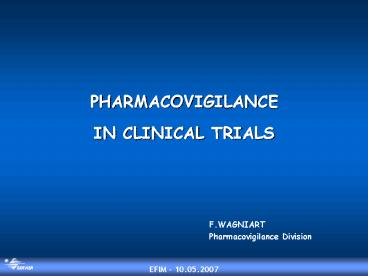PHARMACOVIGILANCE IN CLINICAL TRIALS - PowerPoint PPT Presentation
1 / 14
Title:
PHARMACOVIGILANCE IN CLINICAL TRIALS
Description:
IN CLINICAL TRIALS. F.WAGNIART. Pharmacovigilance ... Management of safety information from clinical trials. Report of CIOMS working Group VI. ... – PowerPoint PPT presentation
Number of Views:428
Avg rating:3.0/5.0
Title: PHARMACOVIGILANCE IN CLINICAL TRIALS
1
PHARMACOVIGILANCE IN CLINICAL TRIALS
- F.WAGNIART
- Pharmacovigilance Division
2
OBJECTIVES
- Safety sections of the SPC
- Investigation of signals (SUSARs)
- SPC Summary of Product characteristics
- SUSARs Suspected Unexpected Serious Adverse
Reactions
3
CAUSATION
- Statistical inference for frequent AEs
- "Causality assessment" for serious AEs
- AEs Adverse events
4
SPONSOR'S RESPONSIBILITIES
? Ongoing safety evaluation of the IMP ? Prompt
notification to all concerned parties of findings
that could affect the health of subjects IMP
Investigational medicinal product
5
RECORDING AND EVALUATION OF ADVERSE EVENTS (AEs)
1. Assessment of seriousness 2. Assessment of
causality 3. Notification
Investigator
Monitor Medical reviewer
4. Completeness 5. Consistency
6. Assessment of causality 7. Assessment of
expectedness
Pharmacovigilance
6
RECORDING AND EVALUATION OF ADVERSE EVENTS (AEs)
1. Assessment of seriousness
? result in death ? is life-threatening ?
requires hospitalisation ? results in
disability or incapacity ? is a congenital
anomaly or birth defect ? other situations
(medical judgement)
7
RECORDING AND EVALUATION OF ADVERSE EVENTS (AEs)
2. Assessment of causality (Investigator's
opinion)
"All adverse events judged as having a reasonable
causal relationship to a medicinal product
qualify as adverse reactions. The expression
reasonable causal relationship means to convey in
general that there is evidence or argument to
suggest a causal relationship" (European
Commission April 2006). "a causal relationship
cannot be ruled out" is no longer in the EU
definition.
8
RECORDING AND EVALUATION OF ADVERSE EVENTS (AEs)
3. Notification (by investigator to sponsor)
"The investigator shall report all serious
adverse events immediately to the sponsor except
for those that the protocol or investigator's
brochure identifies as not requiring immediate
reporting. The immediate report shall be followed
by detailed, written reports" (Article 16 of
Directive 2001/20/EC May 2001) AEs and/or
laboratory abnormalities critical to safety
evaluation Deaths additional information
requested (ECs)
9
RECORDING AND EVALUATION OF ADVERSE EVENTS (AEs)
4. Completeness
? Full description of event ? Onset date (time
if relevant) ? For a fatal outcome, cause of
death ? causal relationship assessment ?
Specific tests and/or treatment required
10
RECORDING AND EVALUATION OF ADVERSE EVENTS (AEs)
5. Consistency
? Get the right chronology positive diagnosis
is not etiological diagnosis ? Risk factors
(atherosclerosis, diabetes) are more likely
causes than events ? Support the positive
diagnosis or syndrome
11
RECORDING AND EVALUATION OF ADVERSE EVENTS (AEs)
6. Assessment of causality (Sponsor's opinion)
"All adverse events judged by either the
investigator or the sponsor as having a
reasonable suspected causal relationship to an
IMP qualify as adverse reactions. The causality
assessment given by the investigator should not
be downgraded by the sponsor. If the sponsor
disagrees with the investigator's causality
assessment, both, the opinion of the investigator
and the sponsor should be provided with the
report" (European Commission April 2006).
12
RECORDING AND EVALUATION OF ADVERSE EVENTS (AEs)
7. Assessment of expectedness
"Adverse reactions should be considered as
unexpected if the nature, seriousness, severity
or outcome of the reaction(s) is not consistent
with the reference information for the IMP"
(European Commission April 2006"
13
REPORTING OF SERIOUS ADVERSE REACTION
? Investigators, Ethics Committee, Competent
authority ? SUSAR or SSAR ? Expedited or
periodic ? CIOMS forms or electronic reporting ?
ASR PSUR SSAR Serious Suspected Adverse
Reaction CIOMS Council of International
Organisation Of Medicinal Sciences ASR
Annual Safety Report PSUR Periodic Safety
Update Report
14
REFERENCES
? Directive 2001/20/EC of the European Parliament
and of the Council of 4 April 2001 on the
approximation of the laws, regulations and
administrative provisions of the member states
relating to the implementation of good clinical
practice in the conduct of clinical trials on
medicinal products for human use. Official
Journal of the European Communities 1.05.2001. ?
Management of safety information from clinical
trials. Report of CIOMS working Group VI. Geneva
2006. ? Detailed guidance on the collection,
verification and presentation of adverse reaction
reports arising from clinical trials on medicinal
products for human use. April 2006. European
Commission.

